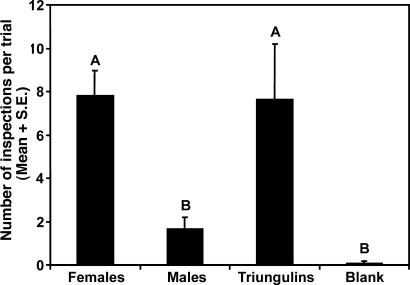Fig. 6.
Attraction of male bees to hydrocarbon blends mimicking the alkene fractions of female bees, male bees, and triungulins as determined from analyses of Figs. 3 and 4 and a solvent control (n = 12). Two-way ANOVA: treatment, F = 21.28, P < 0.0001, df = 3,47; trial, F = 1.61, P = 0.14, df = 11,47. Bars marked by the same letter are not significantly different (Student–Newman–Keuls procedure, α = 0.05). “Females” treatment consisted of (Z)-9-C21 (0.090 mg), (Z)-9-C23 (0.340 mg), (Z)-10-C23 (0.145 mg), (Z)-11-C23 (0.390 mg), (Z)-9-C25 (0.500 mg), (Z)-10-C25 (0.270 mg), (Z)-11-C25 (0.150 mg), (Z)-12-C25 (0.880 mg), (Z)-12-C27 (0.315 mg), (Z)-13-C27 (0.205 mg), (Z)-14-C29 (0.160 mg), (Z)-9-C31 (0.140 mg), and (Z)-15-C31 (0.310 mg). “Males” treatment consisted of (Z)-9-C23 (0.438 mg), (Z)-9-C25 (0.500 mg), and (Z)-9-C31 (0.234 mg). “Triungulin” treatment consisted of (Z)-9-C23 (0.305 mg), (Z)-11-C23 (0.068 mg), (Z)-9-C25 (0.500 mg), and (Z)-11-C25 (0.143 mg). Control treatment consisted of 50 μl of hexane.

